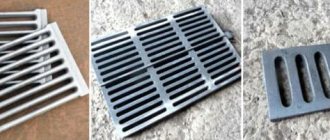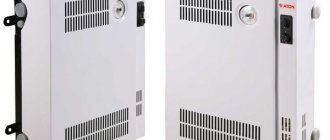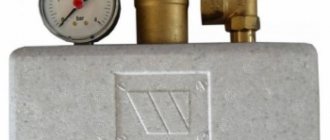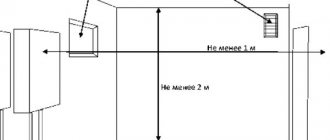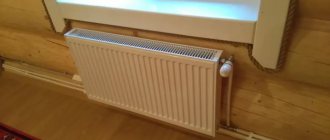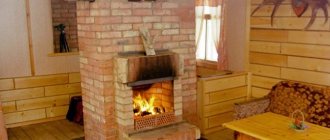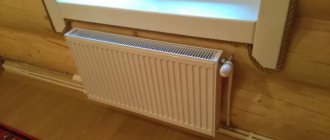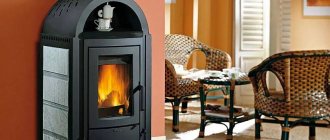Why is it needed?
As has already become clear, the grate is a grate that allows the air flow to penetrate directly to the combustion center below, and the ash to be removed through the holes to a specially designated place for it. So why do we need grates in a furnace? Installing a grate in a furnace allows you to solve a number of problems:
- Divides the combustion chamber into two zones - the combustion chamber itself and a niche for ash.
- Used for placing and drying fuel.
- Distributes the air flow from the ash pan.
- Promotes good traction.
- Together with the door it makes it possible to control and regulate the flame.
The grate, which is intended for installation in the stove, cannot be made from any metal. Since it is constantly exposed to high temperatures and oxygen, it can begin to oxidize very quickly. Only cast iron can survive in this environment for a long time
What are the types of cast iron grates?
This product is available in four different forms . A cast iron grate intended for installation in a furnace can be:
- Flat tiled.
- Beam.
- Basket.
- In the form of a movable lattice.
How to choose the right product for a certain size of stove and the type of fuel used in it?
In order for the cast iron grate installed in the furnace to serve for a long time, it should be selected taking into account the fuel used. For example, a product whose size is 250, 300, 330 by 252, 140, 250 by 180 or 140 by 120 is better suited for use as firewood or briquettes. But for coal, the cast iron grate should have a different size: 300 or 350 by 205 . This difference is motivated by the fact that when coal burns, a much larger amount of aggressive combustion products is released.
The thickness of the rods from which the product is made is of great importance. This determines the maximum mass of fuel that can be put into the stove.
As for the clearance area, a good cast iron grate should have a value of this indicator within 40%. And it doesn’t matter whether it’s a composite beam product or a cast slab. But a decrease in the clearance area can lead to insufficiently complete combustion of fuel and increased formation of gases.
A cast iron grate intended for installation in a furnace can have any shape, but its quality is judged by the material from which it is made, as well as by the thickness of the rods and the size of the slots.
Design features and types
The grate is a grate with separate elements that perform the function of maintaining fuel in the combustion chamber. Based on the design, it is customary to distinguish the following types:
- Flat tile grate. This grate for the furnace is the most common. It is also used in boilers and fireplaces. Its difference lies in certain dimensions. This nuance must be taken into account when laying the stove manually. An installation platform is required for installation into a heating device. It should be easy to remove and the gap should be at least 50mm. After all, almost all grates are made of cast iron, and when expanded, it can cause harm to the combustion chamber and ash pan.
- Beam lattice. This cast iron grate for the stove is stackable. The number of elements must correspond to the dimensions of the firebox. The beam option is the best for arranging a non-standard handmade stove. However, it is necessary to remember about the standards for its length.
Beam grate for oven
- Basket-shaped. Such grates can be used in open fireboxes. Recently, they are installed quite rarely, because a heating device of this type has lost its relevance.
Basket-shaped grate
- Movable grid. The main function in this case is to limit the size of the gap between the grates through the shift of the moving part in the horizontal plane. This is quite convenient for the automatic operation of long-burning stoves.
Movable grate design
The grate and its purpose
A grate is a grate that allows direct access to air flow to the place where wood is burned. In addition, ash and ashes are given the opportunity to fall down into a specially designated niche. The grating material is usually steel or cast iron.
Thanks to cast iron grates, the following goals are achieved:
- Two compartments are formed in the firebox - the combustion chamber and the ash pan.
- A convenient place appears for storing and drying fuel.
- The air flow from the ash pit is evenly distributed.
- Traction takes on a new level of quality.
- With the help of a door and a rod, it is possible to conveniently adjust the combustion process.
Not every material is suitable for making stove grates. The fact is that it is exposed to significant temperatures, which in combination with atmospheric oxygen provokes a fairly intense oxidation process. Only cast iron can effectively withstand such a set of aggressive influences.
Dimensions of grate for the furnace
The dimensions of cast iron grates for a furnace depend on the type of fuel. Their possible sizes are presented in the table.
| Firewood | Coal |
| 330*252 mm | 350*205 mm |
| 300*252 mm | 300*205 mm |
| 250*252 mm | |
| 250*180 mm | |
| 140*180 mm | |
| 120*140 mm |
If it is necessary to install beam gratings, you need to remember that the length is 250, 330 and 470 mm.
How much does a cast iron grate cost?
A cast iron grate designed for installation in a stove or fireplace can be purchased, on average, at the following prices:
- A product of the KP-5 model, the size of which is 800 by 200 millimeters, will cost from 1,100 to 1,500 rubles.
- Models KP-6, size 915X250 mm - from 1,000 to 3,170 rubles.
- KP-7, 260X54.5 will cost 400 - 450 rubles and so on.
You should buy this accessory for installation in the oven in specialized stores that have a wide selection of similar high-quality products. You can safely focus on two main parameters - the weight of the product and its price. It should be remembered that a cast iron grate cannot have a small mass and a low price.
It is usually made from a special heat-resistant cast iron grade - SCh 15 (20). Manufacturers sometimes save on material by using low-quality steel. An accessory made of such material is, of course, cheaper, but quickly loses its performance properties and requires replacement.
The product that will last the longest is in the form of a beam with a ribbed surface. In this case, the area of contact between the metal and the aggressive environment is minimized, which will significantly extend the life of the accessory.
Recommendations for selection
When choosing a specific model, you should take into account the type of fuel that you plan to use. Take note of the size chart above. The grate must be taken in such a way that the rods can easily support the maximum possible weight of one fuel portion. This information can be clarified with a store consultant or specialist.
To clear ash, it is better that the gaps occupy at least 40% of the area of the entire structure. If there are fewer of them, the combustion chamber will not function as efficiently, because the volume of incoming air will be small for good combustion. If ventilation is poor, gases may accumulate. In the case of large gaps, fuel that has not had time to burn out will fall into the gaps along with the ash.
How the grate is mounted and works
The installation site for the cast iron grate for RD-3 furnaces is the lower section of the fuel combustion chamber. There should be a minimal gap between the brick wall and the cut of the grate: sand is poured into it. It acts as an expansion joint, leveling the thermal expansion that occurs with the cast iron element. Thanks to this, the brickwork receives protection from destruction.
Firewood is loaded into the fuel compartment on top of a cast iron grate and set on fire. RD-3 demonstrates high resistance to the destructive effects of heat, combustion products and oxygen. This provides it with a fairly long service life, with full preservation of all operational characteristics.
Classification of grate
Cast iron grates for stoves were and are still the best option. Steel is less resistant to this mode of operation and is not able to accumulate heat, as cast iron does. Therefore, despite the heaviness of the material, it is cast iron wood-burning stoves - Harvia, for example, and cast iron grates that are considered the best. Moreover, this applies to models both for baths and for heating living quarters.
However, this classification exists:
- steel gratings are lighter. If you know how to handle a welding machine, they can be made with your own hands - for a bath structure, for example. However, the material burns out faster because it is less resistant to chemically aggressive substances.
- Cast iron grates for sauna stoves or other structures are much more stable and, therefore, have a long service life.
Another classification of devices is related to the type of device.
- Fixed - usually a lattice with different sizes for different types of construction. This element does not change its parameters and does not move. There are several types of grating: tiled flat - lattice flat rectangle. This is the most popular option and is used for any wood-burning sauna stoves, solid fuel heating boilers, fireplaces, and so on. The photo shows the Harvia model.
- basket - designed for open fireboxes and originally developed for cooking. This device is no longer used, and there are almost no open fires, so the popularity of this model is not great;
- beam - in appearance they resemble a construction beam. The lattice of them is assembled with your own hands, choosing the appropriate size and quantity. This is the best method for fireboxes of non-standard sizes.
Movable grates are extremely rare in everyday life, as they are designed for long-term heating devices. Such an element consists of several gratings and a shaft. When changing the angle, the size of the clearance also changes, which allows you to effectively regulate the heating. Based on the angle of rotation, devices are divided into swinging and full-rotating.
The chain grate belongs to the same category: its elements are connected by chains. However, in practice it is extremely rare, since it does not ensure complete combustion.
A little history
Previously, firewood was burned on a blind hearth - combustion air was supplied through a slightly open fire door.
This method has a fire hazard - coals may fall out of the firebox. It is also difficult to accurately select the optimal combustion mode - the regulator is very rough. The ash that covered the coals over time also did not contribute to the normal combustion of fuel - it is an excellent heat insulator (in the combustion chamber of a Russian stove, this is exactly how coals were stored in the ash for the next kindling). Therefore, they began to install a grate - a grate on the hearth through which oxygen enters the combustion zone. The ash is also removed through the grate - nothing interferes with the combustion processes. The absence of a grate or its damage is not critical - the stove operates without it. True, the efficiency is somewhat lower. And the zone of intense heating of the masonry moves below the hearth - now the base of the ash chamber is also heated. And here you need to be careful if the stove is installed on a wooden base.
Options for grates and their cost
There are various options for grates on sale for installation in stoves, fireplaces and boilers. As mentioned above, these products are made of cast iron or steel.
Cast iron should always be considered the optimal material. And the best grade of cast iron for the manufacture of heat-resistant fittings is SCh-15 (20). This marking is often placed directly on the product.
Grate grates made of steel are cheaper and weigh significantly less than their cast iron counterparts. However, their service life is much shorter, since they begin to deform under the influence of high temperatures, becoming unusable. And if the purchase is planned with the expectation of many years of daily use of the stove, then it is better not to take steel grates into account at all. They are suitable for a decorative fireplace that is lit occasionally, or for a stove that is not used often. For example, it could be an outdoor barbecue complex - you can save on the cost of the product, and for periods of long downtime, the grate can be easily removed and stored in a utility room.
Many foundries are engaged in the production of grates. But you shouldn't think. That the shapes and sizes of products, as they say, “are taken from the ceiling.” This area also has its own standardization.
For example, the products of Litcom CJSC - Rubtsovsky Foundry Complex LDV - are in wide demand. All gratings are manufactured in accordance with the STO 3-2011 standard and developed strict technical conditions. The table below shows grates of different shapes and linear parameters, as well as their cost for 2018.
The symbols are quite clear.
“RU” – grate for coal,
"RD" - grate for firewood.
Products with such indices are intended for stoves, boilers and fireplaces for domestic use with a maximum thermal power of up to 8 kW.
If a grate is required for a more powerful furnace or boiler, then a model with the added letter index “P” is purchased - it indicates the purpose of the product for industrial furnaces or boilers, with a thermal power of 8 to 100 kW.
| Illustration | product name | Linear dimensions, mm | Weight, kg | Approximate cost, rub. (2018) |
| Industrial grate RU-P-10 | 350×100 | 4.5 | 520 | |
| Cast iron household grate RU-1. | 250×250×20 | 4.05 | 520 | |
| Household grate RU-2. | 300×200 | 4.6 | 500 | |
| Household grate RD-8. | 245×220 | 4.1 | 450 | |
| Household grate RD-4. | 250×250×25 | 4.9 | 565 | |
| Fireplace grate RD-7. | 290×135 | 1.66 | 290 | |
| Household grate RU-5. | 300×250 | 3.6 | 430 | |
| Grate catalyst RD-9. | 300×200 | 4.2 | 555 | |
| Household grate RD-6. | 380×250 | 6.4 | 695 | |
| Household grate RD-5. | 300×250 | 5.65 | 695 | |
| Industrial grate RU-P-2. | 520×200 | 14.1 | 1925 | |
| Industrial grate RU-P-1. | 410×200 | 9.96 | 1430 | |
| Industrial grate RU-P-5. | 910×250 | 33.3 | 3990 | |
| Industrial grate RU-P-11.1 | 550×230 | 20.82 | 2395 | |
| Industrial grate RU-P-11.3 | 800×230 | 30.55 | 3490 | |
| Industrial grate RU-P-11 | 618×230 | 23.4 | 2685 |
Of course, the assortment of one manufacturer shown in the table does not at all limit the offer of specialized stores. To decide on the choice of this element of baked fittings, if the meaning of the abbreviation in the model name is not clear, you can consult with the seller or a specialist in this field. But it’s not worth purchasing a grate of unknown origin, as it can fail at the most unnecessary moment. And there are fakes, even those made from some alloys of unclear composition, but passed off as high-quality gray cast iron.
It is important to remember that if the stated material for the grate is cast iron, then by default it cannot be too light and attractively cheap
Homemade grate bars
If it is not possible to purchase a cast iron accessory, grate elements can be easily made from steel with your own hands.
You can weld a frame of the required size from steel reinforcement of variable profile or a rod with a diameter of 24-32 mm, and then mount rods of a material of smaller diameter in it longitudinally or transversely.
Instead of reinforcement, you can use a steel angle.
Important! If you do not have the skills to perform electric welding, you can make longitudinal slots of the required width and length in a steel sheet 8-10 mm thick with a gas cutter or grinder.
Such products will not be durable, but replacing them with new ones when they fail is not difficult.
Criteria for selecting grates for a furnace
The choice of grate is determined by several factors, which include the following:
- Type of heating device (structure).
- The type of fuel used - the grate model will depend on this point. If you plan to heat the stove with coal, then you should purchase more massive grates that can withstand considerable mechanical load and extremely high temperatures. Lighter weight products are suitable for wood fireplaces and stoves.
- The grate must correspond in size to the seat in the combustion chamber. More precisely, the dimensions of the grate are usually immediately included in the design of the furnace, based on the sizes of these products offered for sale.
- The distances between parallel grate bars for wood-burning stoves must total at least 40% of the grate area. This factor will help to avoid difficulties when cleaning the product from ash. In addition, gaps less than recommended will create obstacles to the free circulation of air flow. And this, in turn, will lead to a decrease in the productivity of the heating device, as well as to a decrease in the level of safety of its operation. Insufficient air exchange creates difficulties both for complete combustion of fuel and for normal traction. And the delay of combustion products is unacceptable, as this is fraught with very serious consequences.
If the gaps of the grate are larger than necessary, then not only ash, but also unburned fuel particles will fall into the ash pan. The consequence is a completely unnecessary waste of fuel, since unburned particles of firewood or coal that have fallen into the ash pan will no longer produce the expected heat transfer. And in this case, everything is not very good with security.

